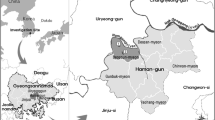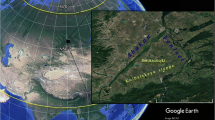Abstract
Lake Hula and its surrounding wetland in northern Israel were drained in the late 1950s and the dried wetlands were transformed into a diverse agricultural region with a 0.3 km2 nature reserve. A portion of the extinct Hula wetland was re-flooded in April 1994 by constructing a small lake, Agmon, and 90 km of canals. The purposes of this study were (a) to document the re-population and colonization of the new Agmon wetland by birds after its flooding, (b) to evaluate bird species richness in this new wetland in comparison to that in a nearby mature Hula Nature Reserve, and, (c) to investigate if the species originally present in the Hula Valley before the drainage had been re-established. The new lake has succeeded in attracting a large variety of water birds to the newly formed habitats, especially ducks, egrets and herons, plovers, waders and snipes. The distribution of bird species among the different habitats was not random. The northern section of the lake, which is shallow and has an open shore, had the largest number of species during 1995 and 1996 and was preferred by plovers, waders and snipes. A large roosting and breeding colony of thousands of egrets and herons was formed in the dense cattails ( Typha domingensis) in the southern section of the lake. Unlike the nearby Hula Nature Reserve, the new wetland lacks a large seasonally flooded area and is less attractive for feeding and breeding plovers, waders and stilts. The new wetland also has very little muddy area without vegetation and attracts few of the species that regularly feed in this habitat in the reserve. The new wetland enlarges the area of only a few of the habitats found in the nearby reserve and therefore attracts fewer species than it might otherwise. Recommendations for management of the new wetland include increased diversity of habitats, restriction of human activities and optimization of conflicts that have arisen between the needs of the wetland and those of nearby agriculture.
Similar content being viewed by others
References
Ashkenazi, S. and Dimentman, Ch. 1998. Foraging, nesting, and roosting habitats of the avian fauna of the Agmon wetland, northern Israel. Wetlands Ecol. Managmt. 6: 169-187.
Creighton, J.H., Sayler, R., Tabor, J.E. and Monda, M.J. 1997. Effects of wetland excavation on avian communities in eastern Washington. Wetlands 17: 216-227.
Degani, G., Yehuda, Y., Jackson, J. and Gophen, M. 1998. Temporal variation in fish community structure in a newly created wetland lake (Lake Agmon) in Israel. Wetlands Ecol. Managmt. 6: 151- 157.
Dehorter, O. and Tamisier, A. 1996. Wetland habitat characteristics for waterfowl wintering in the Camargue, Southern France: implications for conservation. Rev. Ecol. (Terre Vie) 51: 161-172.
Dimentman, Ch., Bromley, H.J. and Por, F.D. 1992. Lake Hula: Reconstruction of the Fauna and Hydrobiology of a Lost Lake. The Israel Academy of Sciences, Jerusalem.
Furness, R.W. and Greenwood, J.J.D. (eds.) 1993. Birds as Monitors of Environmental Change. Chapman and Hall, London.
Green, A.J. 1996. An assessment of which Anatidae taxaqualify for globally threatened status. Gibier Faune Sauvage (GameWildl.). 13, special issue vol. 1: 777-798.
Halse, S.A., Williams, M.R., Jaensch, R.P. and Lane, J.A.K. 1993. Wetland characteristics and waterbird use of wetlands in Southwestern Australia. Wildlife Res. 20: 103-126.
Hambright, K.D. and Zohary, T. 1998. Lakes Hula and Agmon: destruction and creation of wetland ecosystems in northern Israel. Wetlands Ecol. Managmt. 6: 83-89.
Kaplan, D., Oron, T., and Gutman, M. 1998. Development of macrophytic vegetation in the Agmon wetlands of Israel by spontaneous colonization and reintroduction. Wetlands Ecol. Managmt. 6: 143-150.
Karmon, Y. 1960. The drainage of the Huleh swamps. Geogrl. Rev. 50: 169-193.
Kingsford, R.T. and Thomas, R.F. 1995. The Macquarie Marshes in arid Australia and their waterbirds: a 50-year history of decline. Environ. Managmt. 19: 867-878.
Kushlan, J.A. 1993. Waterbirds as bioindicators of wetland change: are they a valuable tool? In:Moser, M., Prentice, U.C. and J. van Vessem (eds), Waterfowl and Wetland Conservation in the 1990's - A Global Perspective. IWRB Special Publication 26, Slimbridge.
Madsen, J. 1995. Impacts of disturbance onmigrtory waterfowl. Ibis 137(Suppl. 1): S67-S74.
Oron, T. 1996. Annual Report of the Hula Nature Reserve for 1995. Nature Reserves Authority, Jerusalem (in Hebrew).
Oron, T. 1997. Annual Report of the Hula Nature Reserve for 1996. Nature Reserves Authority (in Hebrew).
Paz, U. 1965-1972. Summary of Midwinter Waterfowl Census in Israel. Israel Nature Reserves Authority, Jerusalem (in Hebrew).
Paz, U. 1976. The rehabilitation of the Hula Reserve. In:Paz U. (ed.), Nature Conservation in Israel: Research and Surveys, No. 1. pp. 116-206. Nature Reserves Authority, Jerusalem.
Prigioni, C. and Galeotti, P. 1989. Factors affecting the winter distribution of wildfowl in the valley of the Ticino River (northern Italy). Boll. Zool. 56: 81-86.
Rose, P. 1995. Western Palearctic and South-West Asia Waterfowl Census 1994. IWRB Publication 35, Slimbridge.
Shirihai, H. 1996. The Birds of Israel. Academic Press, London.
Shy, E. 1988-1997. Summary of Midwinter Waterfowl Census in Israel. Israel Nature Reserves Authority, Jerusalem (in Hebrew).
Shy, E. 1996. Effect of habitat types and climatic factors on wintering duck (Anatinae) populations in Israel. Gibier Faune Sauvage (Game Wildl.). 13, special issue vol. 1: 261-274.
Skagen, S.K. and Knopf, F.L. 1994. Migrating shorebirds and habitat dynamics at a prairie wetland complex. Wilson Bull. 106: 91-105.
Suarez, S. 1973-1987. Summary of Midwinter Waterfowl Census in Israel. Israel Nature Reserves Authority, Jerusalem (in Hebrew).
StatSoft, Inc. 1995. Statistica for Windows 5.0. Tulsa, Oklahoma.
VanReesSiewert, K.L. and Dinsmore, J.J. 1996. Influence of wetland age on bird use of restored wetlands in Iowa. Wetlands 16: 577-582.
Weller, M.W. 1995. Use of two waterbird guilds as evaluation tools for the Kissimmee River restoration. Restoration Ecol. 3: 211- 224.
Author information
Authors and Affiliations
Rights and permissions
About this article
Cite this article
Shy, E., Beckerman, S., Oron, T. et al. Repopulation and colonization by birds in the Agmon Wetland, Israel. Wetlands Ecology and Management 6, 159–167 (1998). https://doi.org/10.1023/A:1008411900968
Issue Date:
DOI: https://doi.org/10.1023/A:1008411900968




